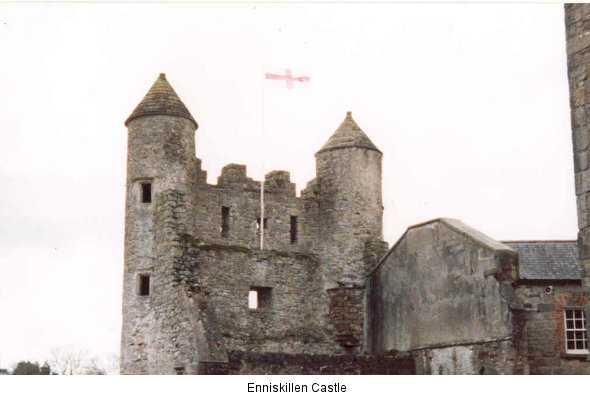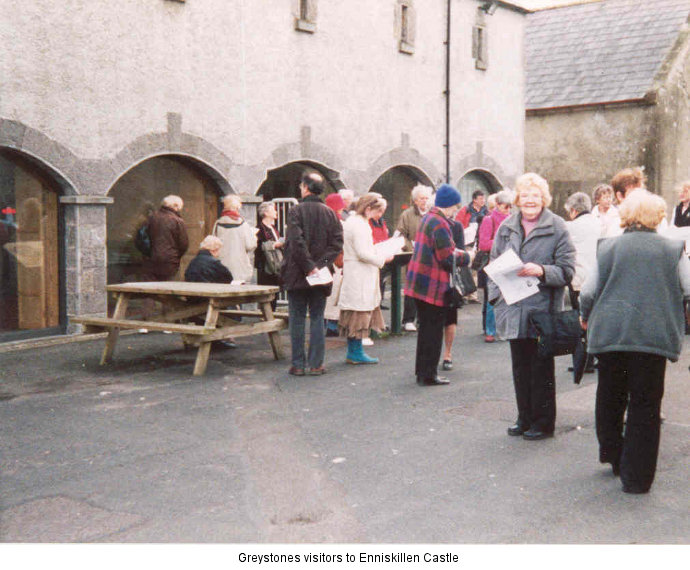Journal Volume 5 2006
Tour to Counties Cavan and Fermanagh, March 2005 (continued/3)
We also say the library, which is not a large room. The shelving here survived the fire and some books, which had belonged to the Sixth Earl, have been bought back from Trinity College Cambridge. One touch I liked here was the high fender with padded top for resting and warming the feet! Indeed, heating these great houses must have been a permanent preoccupation for the staff.
In some of the smaller rooms downstairs we saw memorabilia, addresses and certificates belonging to the family. We saw too the large kitchen in the basement with its interesting utensils: butter knives, sieves and bowls; laundry implements; large mangle and old irons. The servants had their own sitting-room and other quarters in the basement area. New tea-rooms and a little shop have recently been opened here and we enjoyed our coffee and scones. We availed of the tea-rooms in the basement of Castle Coole also. It is noticeable that the Greystones Archaeological and Historical Society really appreciate these amenities on their travels in pursuit of history.
Our next port of call was Maguires' (Enniskillen) Castle, with its two tall turrets, which we saw from the inside. It is even more impressive from the far side of the Lough, where the turrets can also be seen to hang down over the waters - and thus they have stood for the past six hundred years or more, keeping a watchful eye over Lough Erne. This little castle had three floors and a well for fresh water in the ground floor. When we see it in a sketch or reproduction, it immediately spells Enniskillen or Fermanagh for us and, of course, the town grew around it.

In the complex of castle buildings today are:
(1) Restored buildings to the left of the castle to house new County Offices, where we assembled, having alighted from the coach.
(2) The castle keep (presumably after the castle itself) is considered to be the oldest building in Enniskillen. It is a large three-storey high block and now houses a museum, the main interest being the Inniskillen Fusiliers, or ‘Inniskillings’ as they were commonly called. We hear of them mainly in connection with the First World War though they were not in fact disbanded until 1968. Much of the militaria dates from that war, but there is a portion of Napoleon's bed from St. Helena, where the Fusiliers had guarded him. Lots of silver and silver plate are on display. The various regiments, orat least the officers, carried and used these luxuries even in war. (We certainly saw on our four-day tour how much class distinction has changed in the last hundred years.)
(3) Another very old building to the right of the castle and behind the keep is a restored semi-circle of terraced stables and coach-houses, some of which have been given over to craft shops. The upper storey of these stables had at one time been a military hospital.

But to get back to the castle itself, outside of which stands a large cannon with an inscription saying the cannon was captured in the 1914 war (29th October, 1914). This castle was built by the Maguires and they lived and held sway there for many centuries. However, in 1595, the Maguires were defeated by a Captain Cole, thus starting another dynasty in Enniskillen. It is said a cousin led the enemy in through a side gate; such are the vagaries of history. The Cole family lived in the castle for some time before the days of Florence Court. But this gem of antiquity will always be known as Maguires' Castle - the Maguires of Fermanagh.
Thursday 24th March 2005
On our way home on Thursday, we visited the Cavan County Museum in Ballyjamesduff. This museum was formally opened by the then President, Mary Robinson, on the 17th June, 1996. It is housed in what had formerly been a Poor Clare convent and school. The collection is very extensive, covering items of interest to archaeologists, military historians, sports enthusiasts, writers and much more. We had an excellent speaker to guide us around the building, after which we had an opportunity to rest our feet in the tea-rooms.
Our last visit of the day, and of the tour as a whole, was to the Cavan Crystal Visitor Centre where, to my surprise, a hotel has now been added. We visited their show-rooms where many small Irish made goods, apart from crystal, were available on sale. I have just now gone to my Cavan Crystal carrier bag (to check my spelling of the word ‘crystal’!) and on opening it, I am greeted with delicious aromas of heather and moss soap and solid crème Cologne. So on that fragrant note I will end this piece about our trip to Fermanagh and Cavan.
The Greystones Archaeological and Historical Society have to date had twelve annual four-day tours and I am fortunate to have been on all twelve. These tours have been pleasant as well as being informative, we have had comfortable coaches and good drivers, have enjoyed the best of hotels, have had some excellent guides imparting their local knowledge of all the various places we visited. May I conclude, therefore, by commenting that the tours have proved to be a most worthwhile way of seeing Ireland.


